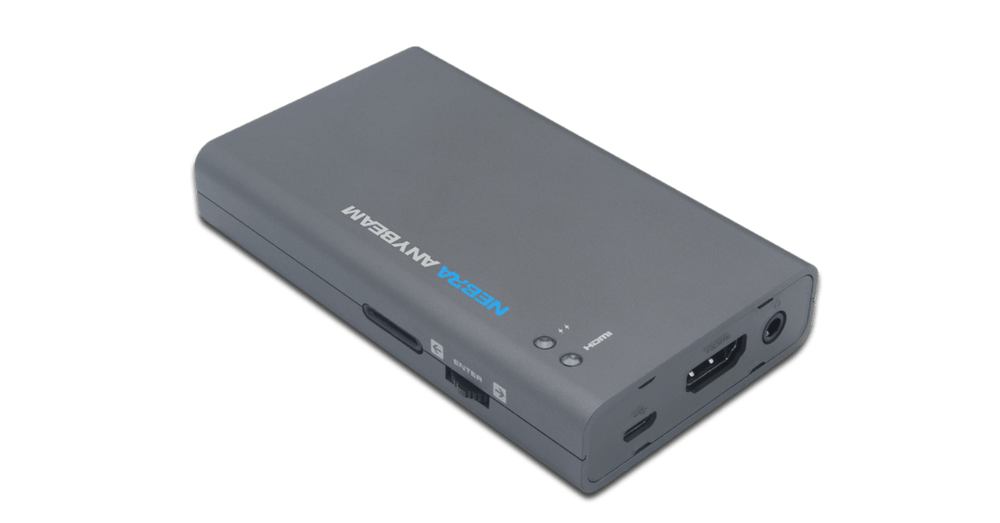Nebra Anybeam laser projector puts a cinema in your pocket
A trip to the pictures, courtesy of your pocket

A cinema in your pocket is the dream of many a movie fan. Being able to rock up anywhere you find a big flat wall to project your favorite films onto at the drop of a hat makes us ready to spill our popcorn in fevered anticipation.
Portable projectors aren’t exactly a novelty these days, with everything from the superb Nebula Mars 2 to the flawed-but-innovative Samsung Galaxy Beam smartphone line having already caught our eyes. But the newly-crowd funded Nebra Anybeam continues in this tradition, claiming to be the world’s smallest pocket cinema projector, with a few tricks of its own up its sleeve.
It’s quite the claim, but with the Nebra Anybeam sat in the palm of your hand, it’s definitely making a good attempt – it’ll easily fit into all but the tightest of pockets, measuring just 19 x 60 x 103mm, and weighing a mere 140g. It makes not only transporting the projector easy, but placing it for a viewing session simple too, as it takes up so little space.
Despite its size, the Nebra Anybeam sports a full size HDMI port. That means it can connect up to almost any AV equipment you can think of, from a games console to a laptop to a streaming stick. Plug something like a Google Chromecast into the back of it, and you’ve essentially got a pocketable casting device.
- The best portable projectors of 2019: top mini projectors for work and play
- The best projector prices and sales this month

The big picture
The Nebra Anybeam can display 720p resolution images and videos up to 150 inches in size, depending on the distance it’s placed from the surface it is beaming onto. As it’s using a laser projection system, with its beam hardly spreading as it leaves the device, it’s incredibly good at keeping in focus, no matter the image size. All you need to worry about is keystone correction (the setting which alters a projection's shape to avoid getting a parallelogram image), which can be adjusted by a menu setting. Menus are navigated by a multi-directional button, which includes a long-press function for accessing different setting options.
As the projection system is using lasers instead of an LED or bulb, the device can be kept within a small housing, due to the fact it generates far less heat – there’s no need to tuck a fan away in with the rest of the internals. It also has the knock on benefit of being very quiet in operation, as projector fans can be quite noisy otherwise.
That’s a positive, given that there’s just a 1 Watt speaker onboard here. It’s about as useful as listening out for a dormouse's whisper. Thankfully, there’s a 3.5mm jack on board for hooking up an external speaker, but it does diminish the projector’s portability somewhat.
Get daily insight, inspiration and deals in your inbox
Sign up for breaking news, reviews, opinion, top tech deals, and more.
Likewise, there’s no internal battery here. You’re going to have to keep the Anybeam connected to the mains, or keep a portable charger handy. But it’s powered over a simple microUSB connection, meaning even a laptop can keep it juiced – the fact we’re at a stage where a projector can be powered by a portable charger alone (power consumption here is listed as low as 3 watts) is a marvel in itself. We'd hope to see one complete with its own battery power built in should a second iteration ever make it to market.
The projection choice also greatly extends the projectors lifespan, however, with a laser system capable of outliving its bulb counterpart by as much as ten times.

Laser performance and build options
So what of the image quality itself? Given the form factor, it’s surprisingly good. To expect a level of performance equivalent to a full size LED projector would be foolish – at 30 ANSI lumens, with a claimed 80,000:1 contrast ratio, it’s not going to worry HDR projector manufacturers.
But as a pocketable device, it does remarkably well, boosted by its versatile form factor. In a well-lit room you’ll struggle to get a strong, rich image from the projector at anything but the shortest of distances from a surface. But dim the lights and pull the blackout curtains across and you’ll be able to get a very watchable image. It’s probably best suited to the mobile presentation-giver than the cinephile, but it’ll make for an interesting option for festival goers and viewing sessions under the stars.
Nebra’s projector gets even more interesting with its line-up of different Anybeam version options. We’ve had the standard, standalone Anybeam in the office, which we’ve described above. That costs £219 (about $285 / AU$410). But it’s flanked by a further three Anybeam options. The £199 ($260 / AU$370) Anybeam Dev Kit is essentially the same as the standalone version, but comes without the casing enclosure, letting you build it into any device of your choosing. For the same price, the Nebra Anybeam HAT takes the concept and turns it into a Raspberry Pi compatible module, while £249 ($325/ AU$465) bags you the Nebra Anybeam Monster, putting the standalone device into a larger, eyeball-like case.
It’s a solid offering from the crowd-funded project then, so long as you keep your expectations in check. Expect the range to go on wider release from August, when its shipping date is due to be hit.
- The best projectors 2019: 8 projectors to consider for your home cinema
Gerald is Editor-in-Chief of iMore.com. Previously he was the Executive Editor for TechRadar, taking care of the site's home cinema, gaming, smart home, entertainment and audio output. He loves gaming, but don't expect him to play with you unless your console is hooked up to a 4K HDR screen and a 7.1 surround system. Before TechRadar, Gerald was Editor of Gizmodo UK. He is also the author of 'Get Technology: Upgrade Your Future', published by Aurum Press.
